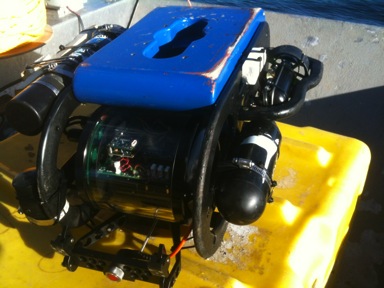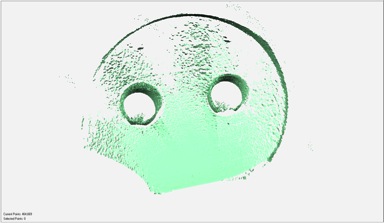Temporary Bulkheading for Valve Replacement at a High Head Dam
This project was at a dam in the western United States where the pressure piping that would need to be plugged for valve replacement was approximately 1700’ into a diversion tunnel. This diversion tunnel has an intake structure on the bottom of the reservoir at approximately 675’ of depth. The intake structure has a trash rack that is made of concrete with steel reinforcements that could not be removed without cutting, and it was expected from previous bathymetric surveys taken from the surface that the intake would be covered almost entirely with sediment.
 Figure 6 Hibbard Inshore Modified Seabotix LBV600-6 ROV with Multiple Sensors
Figure 6 Hibbard Inshore Modified Seabotix LBV600-6 ROV with Multiple Sensors
Hibbard Inshore worked with the customer to discuss options for inspection of the tunnel, confirmation of sediment levels, methods for accessing the tunnel, and methods for placement of a temporary plug to allow the valve replacement to be completed. The customer decided that an initial inspection would be necessary to determine the proper bulkhead design and to propose any necessary sediment removal along with a method to remove and replace a section of trash rack.
Due to the level of error in the bathymetric survey, it was agreed that in performing the initial inspection, Hibbard Inshore would bring an ROV with the capability of carrying video cameras, 2D sonar, and an ultrasonic thickness sensor while fitting between the 12” vertical gap between the beams of the trash rack, and a special tool skid would be built to transport the 3D sonar unit through this gap as well. Hibbard Inshore used its Seabotix LBV600-6 ROV to accomplish this task. Bringing an ROV prepared to swim through the trash rack bars proved to be a good decision as when the ROV descended to depth, it was shown that the primary intake was sufficiently uncovered to enable entry of the ROV. The ROV entered, travelled the 1700 feet to the pressure piping and was able to determine that each conduit could be plugged. The process also allowed the customer to consider whether both pipes should be plugged concurrently to minimize risks to each pipe from the other during the valve replacement. This inspection gave the customer the data they needed in order to have a third party engineering firm evaluate the situation and prepare recommendations to move to the construction of the project.
 Figure 7 3D Sonar Scan of 2 Pipes and Concrete Sealing Face taken by Hibbard Inshore LBV600-6
Figure 7 3D Sonar Scan of 2 Pipes and Concrete Sealing Face taken by Hibbard Inshore LBV600-6
The lesson found in this project is that if you are looking to evaluate replacement of gates or valves, using a smartly outfitted ROV along with a ROV installed bulkhead is a solution that can effectively complete the project from initial inspection to final installation and removal, reduce costs versus dewatering, and can improve safety by eliminating the need for people to be in the water.

